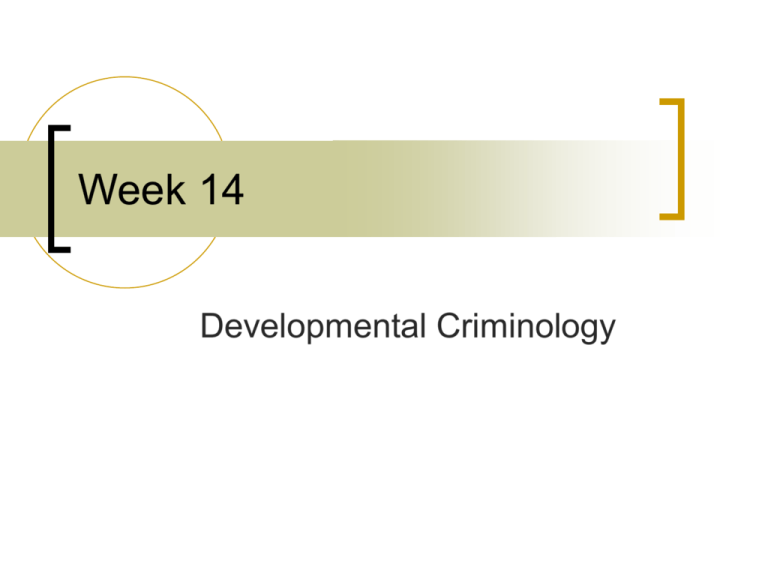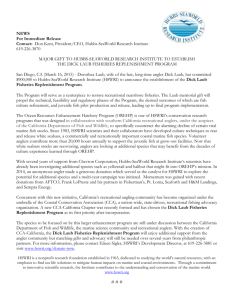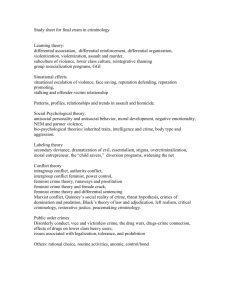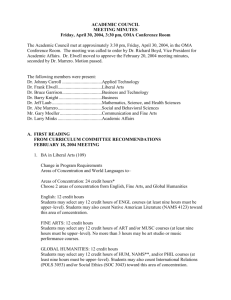Developmental
advertisement

Week 14 Developmental Criminology What do we know? There is a very strong correlation between past and future criminal behavior Adult antisocial personality virtually requires a childhood of antisocial behavior BUT: Half of antisocial children are never arrested and never become antisocial adults AND: The vast majority of delinquents desist as they enter adulthood (recall the age crime curve) What do we want to know? Is criminality stable over time? Why do some people age out of crime (desistance)? Does behavior change over time? How? INDIVIDUAL focus LONGITUDINAL research techniques Sampson and Laub 1980’s - Life Course Criminology Age/crime debate – the curve doesn’t apply longitudinally to individuals… “Age Graded Theory of Informal Social Control” Definitions Age graded/differentiated Informal social control Sampson and Laub Based on extremely famous dataset – Gluecks’ research (500 delinquents and non-delinquents in MA born in 1920s and 1930s) Gluecks’ finding: “all you need to know about an offender is what happened to them as a child” S&L: “maybe there’s more to it…” Sampson and Laub Different factors (forms of behavior or experiences) have different effects on individuals at different stages of development. The level of appropriateness changes over time: (having a baby as a teen v as an adult) (losing a parent as a child v as an adult) Sampson and Laub REALLY important concepts: Trajectories Transitions Long term patterns or sequences of behavior Changes due to specific events (short term) Turning points Transitions that change a person’s trajectory Sampson and Laub H1 The Structural context is mediated by informal family and school social controls, which in turn explains delinquency in childhood and adolescence Structural variables have an indirect influence on offending based on how they affect family process variables Sampson and Laub H2 There is continuity in antisocial behavior throughout the life course Connects delinquent and adult behavior to childhood characteristics and adult socialization Antisocial behavior takes on a variety of forms throughout life Weak social bonds/social capital Sampson and Laub H3 There is evidence for both stability and change in behavior throughout the life course Importance of informal institutions vary over life Impact of early life experiences can be counteracted by ‘salient life events’ Bad childhood doesn’t necessarily spell disaster Sampson and Laub Research: Lots of support Big Contribution: books etc. also, looks at whole life course, not just focused on teens Critique: Unique sample (white males born 1920s) Order? Social bonds crime… or crime social bonds Moffitt Dual Taxonomy Theory Causal factors are different for different people – there are two types of offenders: Life Course Persisters (LCPs) Adolescent Limited (ALs) Life Course Persisters 5% of offenders Early onset (childhood) Continue throughout life Difficult to control early in life (biting drinking burglary) At risk for biol/psych problems and birth defects/injury Reactive or proactive Etiological chain of ASB: negative responses from environment cut off from prosocial opportunities become ensnared in ASB (early pregnancy or drugs) Adolescent Limiteds 90% of offenders Later onset (14-15 yo – adolescence) No childhood ASB Hx or cog/personality probs Learn to be criminal with their peers Situational component makes it integrated MATURITY GAP and SOCIAL MIMICRY Minor, petty crime Desist with the onset of adulthood Cumulative Consequences time-out in preschool detention in grade school expulsion in high school dishonorable discharge (army) divorce from marriage Narrows one’s options for change Critique Generally supported by research Accounts for crime over the life course Best attempt so far at integrating biol/environ/psych/soc variables Not everyone fits into two neat groups Says LCPs can’t or won’t change Complex model, difficult to test Discussion Questions G&H argue that a teen with low SC is locked into a life of crime. What would S&L say? What individual traits foster ASB? Why is it impt to study continuity AND discontinuity in offending? S&L was considered a developmental theory, now it’s considered a control theory. why?




